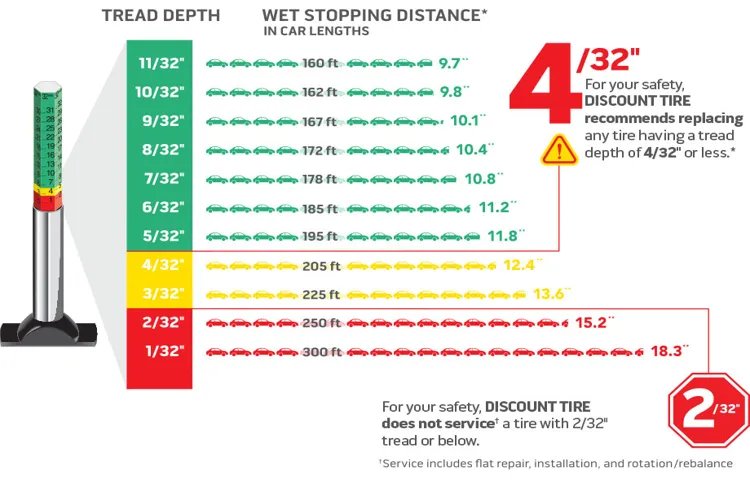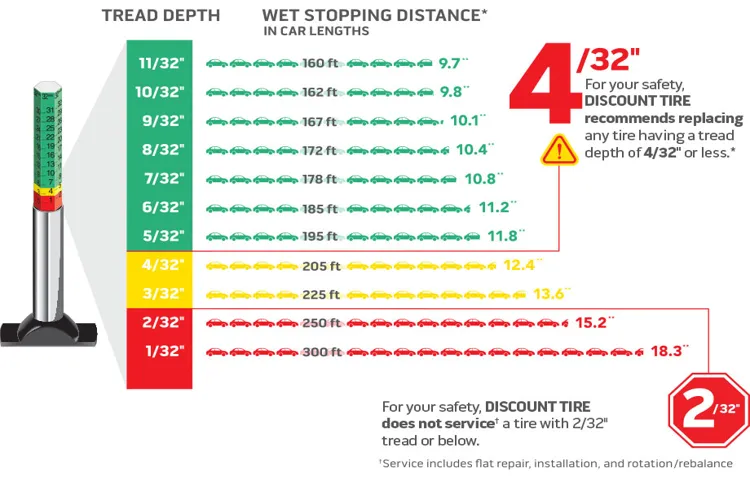Have you ever wondered what is the minimum tire tread depth requirement in Ohio? Well, my friend, you are in the right place. Tire tread depth is an essential factor in maintaining your vehicle’s safety, as it ensures proper traction and braking on the roads. In Ohio, the law requires a minimum tire tread depth of 2/32 of an inch, which is about the thickness of a penny’s head.
This regulation applies to all types of vehicles, including passenger cars, SUVs, and trucks. But why is this minimum tread depth so important, and what can happen if you don’t comply with it? Let’s explore. Your car’s tires are the only part of your vehicle that comes in contact with the road, making them a critical component of a safe driving experience.
The depth of the tire tread affects how much traction the tire has on the road, especially on wet, snowy, or icy surfaces. When your tire treads are worn out, your vehicle’s braking ability and handling are compromised, leading to an increased risk of accidents. This is why Ohio law mandates that drivers keep their tire tread depth above the minimum requirement of 2/32 of an inch.
Failure to comply with Ohio’s minimum tire tread depth requirement could result in a hefty fine and potential legal consequences. Additionally, driving with worn-out tire treads puts you and other drivers on the road in harm’s way. It’s crucial to check your tire treads regularly and replace them when necessary to ensure your safety and avoid legal troubles.
In conclusion, maintaining your vehicle’s tire tread depth above the minimum requirement is critical for your safety and the safety of other drivers on the road. Be sure to check your tire tread depth and replace your tires when necessary to comply with Ohio’s laws and regulations.
Table of Contents
What is Tire Tread Depth?
If you’re driving on Ohio roads, it’s essential to know what the minimum tire tread depth is. Tire tread depth refers to the measurement from the deepest grooves of the tire to the outermost layer of the tread. In Ohio, the minimum tire tread depth for safe driving is 1/16th of an inch or 2/32nd of an inch.
If your tire tread depth falls below this standard, your tires will not be able to grip the road properly, leading to an increased risk of accidents. It’s important to regularly check your tire tread depth to ensure that your tires are safe to drive on. You can use a tire tread depth gauge or the penny test to measure your tread depth.
Don’t take chances when driving on Ohio roads, ensure that your tires meet the minimum tread depth requirement to stay safe on the road.
Definition of Tire Tread Depth
Tire tread depth refers to the measurement from the top of the tire’s tread to the bottom of the grooves. It is an essential aspect of tire maintenance and safety, as the tread depth directly impacts the tire’s ability to grip the road and provide adequate traction. The deeper the grooves, the better the tire will perform in wet or slippery conditions, as it can effectively channel away water or other debris that may cause skidding or hydroplaning.
Tires with worn-out treads are more prone to blowouts and can lead to accidents on the road. Therefore, it is recommended to check the tread depth regularly and replace the tires if they fall below 2/32 of an inch. By doing so, you can ensure your safety and the safety of everyone else on the road.

Ohio’s Minimum Tire Tread Depth
If you are driving in Ohio, it is important to understand the state’s minimum tire tread depth requirements. The current minimum tire tread depth in Ohio is 2/32 of an inch. It may not sound like much, but this small amount of tread can make a big difference for your vehicle’s safety.
Tires with low tread depth can lead to less traction on the road, making it harder to stop quickly or maintain control in wet or slippery conditions. It is recommended that you check your tire tread depth regularly, especially before long road trips or during winter months when driving conditions may be more hazardous. If your tread depth falls below the Ohio minimum requirement, it’s time to invest in new tires to ensure you and your passengers stay safe on the roads.
Current State Law
Ohio’s current state law mandates a minimum tire tread depth of 2/32 of an inch. This means that if your tire tread has worn down to this depth or less, it’s time to replace your tires to ensure that your vehicle can safely navigate the roadways. It’s important to note that this minimum tread depth requirement applies to all passenger and light truck tires in Ohio, and failure to abide by this law can result in a citation and fine.
So, before hitting the road, take a moment to check your tire tread depth and make sure it meets Ohio’s legal requirements. Don’t risk your safety or the safety of others on the road by driving on worn-out tires. Remember, your tires are your vehicle’s only point of contact with the road, so keeping them in top condition is crucial for safe driving.
Penalties for Violating Minimum Tire Tread Depth
Ohio’s minimum tire tread depth is 2/32 of an inch. This means that your tires must have at least that much tread depth to be considered legal. Failing to meet this minimum requirement can result in a fine and even points on your license.
The fine for a first offense can range from $25 to $100, while repeat offenses can result in fines of up to $500. Keeping your tires at the proper tread depth not only keeps you legal, but it also helps with traction and can prevent accidents. Think of it like walking on an icy sidewalk in sneakers versus boots with good tread – which do you think is safer? So, if you’re unsure about the tread depth on your tires, it’s worth getting them checked.
Don’t risk a fine or, worse, an accident, because of worn-out tires.
How to Check Tire Tread Depth
When it comes to driving in Ohio, it’s important to know what the minimum tire tread depth is to ensure safety on the roads. The state requires that tires have at least 1/16 of an inch of tread depth in order to pass inspection. You can check the tread depth of your tires by using a penny or a tread gauge.
Simply take the penny and place it upside down in the tread groove. If you can see the top of Lincoln’s head, your tire tread is too worn and it’s time to replace the tires. A tread gauge will give you a more accurate reading by measuring the depth in millimeters.
Having proper tire tread depth is crucial for maintaining good traction, especially in wet or snowy conditions. So be sure to check your tires regularly and replace them when necessary to stay safe on the road.
Tools Needed
Checking the tread depth of your tires is crucial for maintaining your vehicle’s safety on the road. You don’t need any special skills or tools to do it yourself, just a simple handheld depth gauge. These gauges are easy to find and inexpensive.
If you don’t have one, you can also use a penny to check your tire tread. Place the penny upside down in the grooves of your tire, and if you can see Lincoln’s head, your tread depth is too low. It is essential to check the tread depth regularly, as worn-out tires can lead to hydroplaning, reduced traction, and increased stopping distance.
By taking a few minutes every couple of months, you can save yourself from hazardous road accidents.
Steps for Checking Tire Tread Depth
Tire tread depth is a crucial factor in maintaining safe roads. It is essential to ensure that your car’s tires have enough tread depth to handle wet and slippery road conditions. To check the tread depth, you can use a specialized gauge or go old school and use a penny.
To use a penny, simply insert it into the groove of your tire with Abraham Lincoln’s head facing downwards. If you can see his entire head, then it’s time for new tires. The same applies when using a quarter as a gauge.
The distance between the top of the tire and the metal part of the coin is 4/32 inches. Anything less than this means that it’s time to change your tires. This simple test can save you from facing the dangers of driving with worn-out tires on wet roads, such as hydroplaning or losing control.
Keeping an eye on your tire’s tread depth can keep you safe on the road and save you money in the long run.
When to Replace Tires
If you’re driving in Ohio, it’s crucial to know the minimum tire tread depth required by law. In Ohio, the minimum tire tread depth is 2/32 of an inch. This means that if your tire’s tread depth is less than that, it’s time to replace your tires immediately.
Tread depth is important because it directly affects your car’s traction and ability to grip the road. If your tires have less than the minimum tread depth, they may not be able to grip the road during wet or slippery conditions, which can be incredibly dangerous. It’s also important to check your tires regularly for signs of wear and tear, as uneven wear or bald spots can also be indicators that it’s time for a new set of tires.
By maintaining proper tire care and knowing when to replace them, you can keep yourself safe on the road and extend the life of your tires.
Signs of Wear and Tear
Tire wear and tear can be a tricky thing to identify, but it’s essential to know when to replace your tires. One of the most obvious signs of wear is when the tread depth reaches a minimum of 2/32 of an inch. This can be easily checked using a penny.
Insert the penny into the groove of your tire with Lincoln’s head upside down, and if you can see the top of his head, it’s time to replace your tire. Other signs of wear and tear include cracks on the tire surface, bulges or bubbles, and uneven wear due to poor alignment or suspension issues. It’s also important to keep an eye on the age of your tires, which can deteriorate over time even when not in use.
As a rule of thumb, most tires should be replaced after six years, regardless of their mileage or appearance. Remember that good quality tires are crucial for your safety on the road, and it’s always better to be safe than sorry.
Preventative Measures
One important aspect of tire maintenance is knowing when to replace your tires. While it’s recommended that you replace them every six years, there are other signs to watch out for that may indicate you need new tires sooner. If you notice the tread is worn down to less than 1/16th of an inch, it’s time to replace your tires.
You can also do the penny test by inserting a penny into the groove of the tire with Lincoln’s head facing downwards. If you can see the top of Lincoln’s head, your tire treads are too shallow. Other warning signs include cracks on the sidewall, bulges or blisters, or if you experience vibration while driving.
Replacing your tires when needed can help keep you safe on the road and prevent accidents. So, don’t wait until it’s too late, and keep an eye on those tires!
Conclusion
In Ohio, the minimum tire tread depth is not just a legal requirement, it’s a safety necessity. It’s the amount of rubber that stands between you and the road, and it’s like your car’s own pair of shoes. So don’t skimp on the tread, or you might find yourself slipping and sliding like a penguin on ice!”
FAQs
What is the legal minimum tire tread depth required in Ohio?
The legal minimum tire tread depth required in Ohio is 2/32 of an inch.
What are the consequences of driving with tires that do not meet the minimum tread depth in Ohio?
Driving with tires that do not meet the minimum tread depth in Ohio can result in a fine and points on your driver’s license.
How can I measure my tire tread depth?
You can measure your tire tread depth using a tire pressure gauge or a specially designed tread depth gauge. Place the gauge between the grooves of the tire and read the measurement.
How often should I check my tire tread depth?
It is recommended to check your tire tread depth at least once a month and before any long road trips.
Are there any exceptions to the minimum tire tread depth requirement in Ohio?
Some types of vehicles, such as motorcycles, may have different minimum tread depth requirements. Additionally, tires with visible steel cords or fabric may be considered unsafe, regardless of tread depth.
Can I still pass a vehicle inspection with tires that have less than the minimum tread depth in Ohio?
No, vehicles with tires that have less than the minimum tread depth in Ohio will not pass a vehicle inspection.
What should I do if I am unsure about the tread depth of my tires?
If you are unsure about the tread depth of your tires, take your vehicle to a trusted mechanic or tire specialist for a professional inspection.



